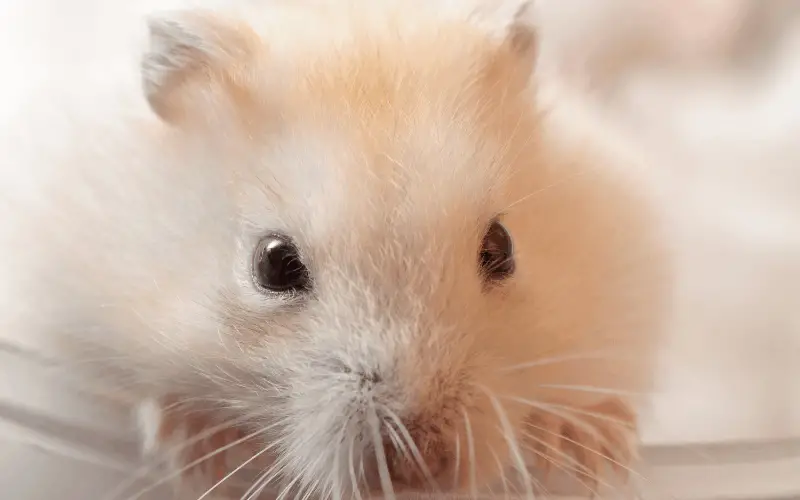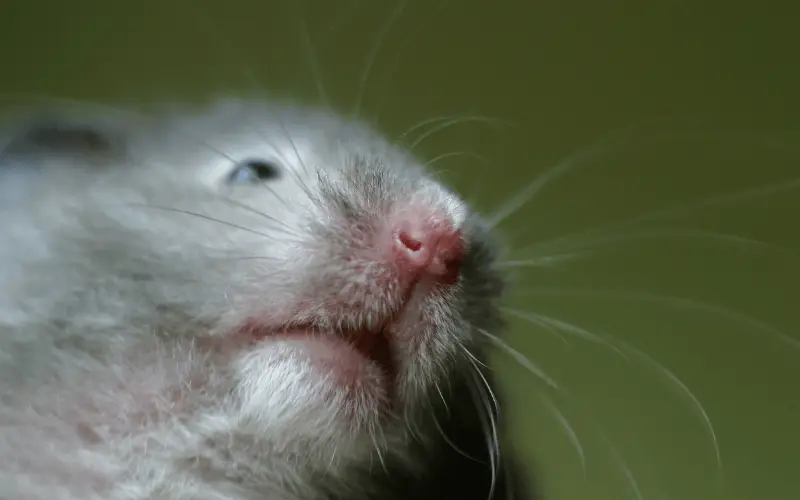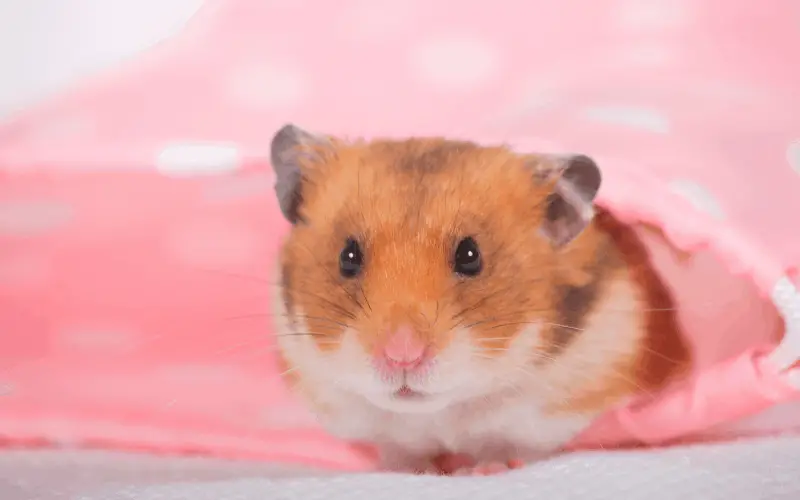You may be wondering, can hamsters see in color? Just like other mammals, hamsters’ eyes are made up of various parts with which they see. Like the human eye, they also have the retina, lens, iris, pupil, and optic nerve. Be it as it may, Hamster’s eyes are mostly spherical and are different in color depending on the species and size.

From a distance, the hamster’s eye appears to be round and uniform in color. That’s to say hamsters can see, but differently from how we humans do.
In contrast, hamsters have a much more full range of eyesight compared to that humans. The eyesight allows them to see at higher angles.
However, the range in front of them is the eye challenge they battle with. Hamster’s eyes, just like human eyes, are susceptible and can easily be damaged if not carefully guarded.
Can hamsters see in color?
No, hamsters don’t see in color. Hamsters are nocturnal animals; this means that they see well at night but have poor eyesight performance during the day.
More so, it turns out that hamsters have 97% of their eyes as rod cells. As a result, hamsters have very little to no color ability. So, they are colorblind.
Can Hamsters See in Color?

Hamsters are quite perfect to have as a pet. As a hamster owner, you will have certain questions bugging you. This is quite natural, as you will want to know the best way to care for your hamster.
If you are wondering if hamsters see in color, the brutal truth is no, hamsters are color blind. In other words, it is practically impossible for your hamster to see color as a result of his poor sight.
They also have a fuzzy vision. Although, hamsters tend to see more into the green/blue/UV end of the spectrum.
What Does A Hamsters Vision Look Like?
You might sometimes wonder if your hamster can see you. Hamsters can see few inches past their noses. This means that they can only see you when you come really close to them.
This makes hamsters nearsighted, meaning they cannot see things far away but only items a few inches in front of their face.
Hamsters generally have a rigid lens, which can’t change shape much or focus light very well.
>>> Read Also: Can Hamsters Eat Lettuce?
Do Hamsters Know Who Their Owners Are?
Fresh out of the pet store, your hamster will not know you. But after a few days, chances are that he will get familiar with your scent and get comfortable around you.
Bonding with a very young hamster is easier than trying to bond with an adult hamster. But with patience and a systematic approach, you can slowly gain the trust of your hamster as you connect with him during the taming process.
Hamsters are conditioned to bond with just one or two persons, but they can tolerate guests and other family members.
What Color Light Do Hamsters Like?
Studies show that hamsters exposed to dim blue light and white light for a long time had symptoms and changes in the brain linked to depression. The hamsters, however, fared better when exposed to red light.
According to the study, hamsters sleep better in the dark.
If you are contemplating whether or not to turn on the light at night for your hamster, it is best if you don’t.
Watch this video: Can Hamsters See in Color?
How Do Hamsters Survive with Their Poor Eyesight?
Hamsters rely heavily on scent and hearing to survive. These animals have excellent hearing ability and even hear better than humans. This heightened ability give them a better chance to detect predators.
Have you noticed that your hamsters become motionless when there is a loud bang? This is an example of his excellent hearing abilities.
The hamster becomes motionless when there is noise to ascertain whether he is in danger. Chances are that once he stays static, the predators would not spot him.
Their heightened hearing abilities make the pets quite sensitive to noise, so it’s best if you minimize loud noises in the house so as not to make your pet tense.
Hamsters also have a great sense of smell used to detect food, communicate with one another, and identify other hamsters’ gender.
Hamsters are quite territorial animals and will use their scent to mark their territory.
Your hamster has a scent gland around his hip side, which he rubs against objects and places to lay claim and ownership of it.
So, you might need to employ more care in cleaning your hamster’s cage, so you don’t clean off his territorial scent.
Always wash your hand before handling your hamster, especially if you just finished eating. You don’t want your hamster detecting the scent of food on your hand and biting off your fingers.
Can Hamsters See in The Dark?
It’s difficult for Hamsters to see well in complete darkness. However, they see best in the low light environment.
Hamsters are naturally crepuscular, that is to say, the most active during dawn and dusk. As such, these two periods in the day, are their best eyesight period.
For hamsters to move in the dark their sense of smell and hearing aids them in finding their part and locating an object.
In a real sense, hamsters act more nocturnal. Simply because most hamsters owners and keepers keep their lights switched off until quite late at night, which means their hamsters lose a few hours of darkness.
Can Hamsters See Well in The Day Time?

Sight in the day is a problem hamsters battle with. As their normal routine implies being active at dawn or dusk but inactive in the day.
Hamsters have no or little need to be up and active during bright hours.
So, hamsters are prey animals, in other words, they could be easy targets during the day from their predators. At dawn or dusk, they’re a lot fewer dangers and predators around that could hunt them.
What Light Condition Do Hamsters Feel Safe Around?
In summary, Hamsters feel more secure and safe in low-light conditions. As such, they are more likely to move out of their nesting area when the lights are off compared to when the lights are turned on.
Do Hamsters Need Lights for Their Cages?
The room your hamster is placed should get plenty of natural light. Please don’t place your hamster directly under the sun. Hamsters don’t like artificial light is safer for your hamster not to have artificial light in his cage.
Artificial lighting will disturb your hamster’s natural sleeping and waking cycles. This can make your hamster distressed and lead to behavioral or aggression problems.
Do Hamsters See Color? Are They Color Blind?
Hamster’s vision is not as advanced as humans, and to make up for that impediment is why other senses like sound, hearing, and small are so great.
Although, it’s difficult, to actually say what and how hamsters see. However, a recent study carried out by a group of vets implied that hamsters see monochromatically.
Simply put, monochromatic eyesight is when every color is seen as a single color.
However, a different study by a group of mammal scientists proved that hamsters are capable of seeing some shades of green and blue. The reason is that 97% of a hamster’s eyes are rod cells.
What does that mean?
It means their eyes have a little light capability, which in turn gives them a very high slim or zero color vision.
>>> Read Also: Do Hamsters Like Bread?
Conclusion
Hamsters only leave their burrows during dawn and dusk in search of food. Because that is when they feel safe.
Also, given the fact that fewer predators are about during these hours, making them less likely to be hunted.
That said, your hamsters have no predators or dangers inside the cage, but the crepuscular patterns are defensive mechanisms inherited from their ancestors.
Your hamster’s eyes are not accustomed to bright light or color as they spend most of their time in the dark, their safest place.
So, that simply means they see much better and more clearly in dim light.
At best, do all to keep your hamsters away from light. Especially sun rays and other types of light that could endanger their eyesight.